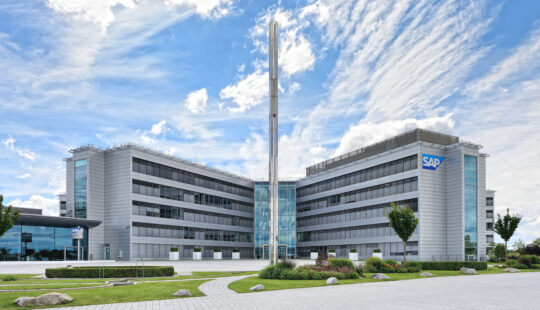In the early hours of February 6, 2023, two massive earthquakes and multiple aftershocks struck southeast Türkiye and northern Syria. Less than a day later, SAP employee Sebastian Hodapp and others from the volunteer search and rescue organization @fire were on the ground in the disaster zone to help locate and rescue victims trapped under rubble.
“We’re a private organization, so we’re flexible and can deploy to wherever we’re needed fast. Every minute is precious in the search for earthquake victims,” says Hodapp, who has served as a volunteer firefighter in his hometown for more than 20 years and joined @fire 12 years ago to use his skills to help save lives abroad, too.
After just a few hours’ preparation, the first @fire team – 17 emergency responders and two search dogs – flew from Germany via Istanbul to Adana in southern Türkiye. As one of the first international response teams to arrive, they began by helping install the UN reception and departure counter at the airport for rescuers flying in from around the world. After that, they set off on a six-hour drive across the mountains to the city of Kahramanmaraş (or Maraş) in southern Anatolia. The Turkish authorities provided them with vans and drivers for the journey.
The Hazardous Search for Survivors
On arrival in Maraş, part of the team began setting up a base camp for the rescuers, while others immediately joined the search for survivors beneath the rubble. They spoke with local residents and with other rescue teams to assess where there might be hope of finding people alive. Because the earthquake hit during the night, most of the victims were trapped in the ruins of apartment buildings.
Once the team had established where to begin looking, the dog handlers moved in with their specially trained rescue dogs, which can search large areas of debris relatively quickly. “The dogs have learned to bark only when they pick up the scent of people who are still alive,” explains Hodapp. When the dog gives a bark alert, the rescuers bring in audio equipment to listen for shouts and tapping sounds. They also use tiny telescope cameras that they can push through holes and cracks to find victims.
When the rescuers locate a survivor, their stress levels rise as they feel the burden of responsibility to do everything they can to get the person out alive. They use a variety of tools, including concrete breakers and drills, to break through areas of damaged buildings that have become inaccessible – often putting their own lives at risk. “We have structural engineers on our team who can tell us whether collapsed buildings are at risk of collapsing further,” says Hodapp. And throughout the rescue mission, specially trained team members provide as much medical care for trapped victims as they can in these difficult conditions.
Hodapp tells us of one very lengthy operation to reach two people who had been on the first floor of an apartment building when the earthquake struck. The rescuers used an excavator and other equipment to access the building through the basement and then worked their way up bit by bit to the trapped victims.
Grueling Rescue Efforts
The team pulled five people from the rubble over the seven days it was in action. One particular rescue was especially emotional for Hodapp, who has a two-year-old daughter himself. “We were trying to free a mother and her six-year-old daughter. And finally, after 20 hours, we got them out,” he explains. “No words can describe the relief and joy we felt in that moment. But there’s little time for these emotions because we have to move on to the next rescue. And that’s why this work is so grueling.” In the first evening they were there, the team members rescued four people. Two days later, they managed to free a 15-year-old girl.
Hodapp and the team spent one week in Maraş: “The chances of finding someone alive seven days after an earthquake is very small – especially in such bitterly cold temperatures, which are partly below freezing, especially at night,” he says. Hodapp is reassured by the fact that several international teams have stayed behind to complete the final search and rescue operations. Having liaised with the United Nations Disaster and Coordination (UNDAC) organization, @fire stood down on Saturday evening.
The team headed back to Germany on Sunday morning. Hodapp says: “Dramatic situations like these remind us of how fortunate we are. I’m humbled and grateful to be able to return to my family and to a house that is safe. The people affected by the earthquake face months or perhaps even years of adversity.”
Life Lessons from Relief Work
At SAP, Hodapp manages the local IT organization for SAP’s regional offices in Germany and the IT Event Services unit for EMEA. “I’m lucky to have a team that is willing to cover for me at short notice and a manager who lets me take time off so I can join disaster relief missions,” he says.
He explains how his training as a rescuer and the deployments he has been on have changed his outlook on life and his approach to his job: “Relief work has taught me to keep calm under pressure – and to first decide how best to deal with a situation and then to act decisively. These are skills that help me at SAP, too.”
Hodapp also relates how teaming up with rescuers from across the world has helped him improve his ability to communicate and work with people from diverse cultural backgrounds. It has taught him that success takes teamwork, cooperation, and flexibility. Understanding this helps him perform better as a leader at SAP.
As one of @fire’s directors, Hodapp devotes much of his spare time and energy to the organization. Doing so also gives him so much back in return. To anyone who is wondering whether to become a volunteer for an organization, he says: “It is such a great feeling to do something for the community and make a difference. Just try it – I’m sure you’ll find it as rewarding as I do.”
Top photo courtesy of @fire



